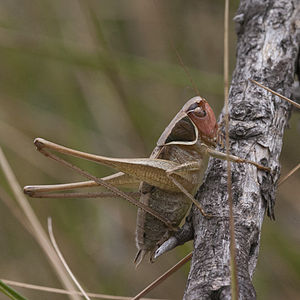Fence insect
| Fence insect | ||||||||||||
|---|---|---|---|---|---|---|---|---|---|---|---|---|

Common fence insect ( Sepiana sepium ) |
||||||||||||
| Systematics | ||||||||||||
|
||||||||||||
| Scientific name of the genus | ||||||||||||
| Sepiana | ||||||||||||
| Zeuner , 1941 | ||||||||||||
| Scientific name of the species | ||||||||||||
| Sepiana sepium | ||||||||||||
| ( Yersin , 1854) |
The fence insect ( Sepiana sepium ) is a long- feeler insect from the subfamily of the Tettigoniinae within the superfamily of the leaf locust .
features
At first glance, the fence insect is very similar to the Roesel's bite . It has very long hind legs with small spines on the lower legs. The antennae are about body length, the unspotted brown wings reach to the middle of the abdomen. The cricket has a gray-brown to reddish basic color, but in contrast to the Roesel's bite, does not show any green areas on its body. Your pronotum side lobes are bordered black, light yellow or whitish and clearly delimited in color from the upper side, which is often darkly drawn, by a light longitudinal line. There is a dark spot above the reddish-brown compound eye, which is divided backwards by a whitish line. The lower head is often tinged with red. The abdomen is largely monochrome. The legs are colored dark brown or dark gray. There is a black stripe on the back of the thigh, which is bordered light gray at the front and dark at the back. The male's cerci are dentate just past the middle. In the female, the 6th and 7th abdominal plates each have a pair of cusps. The fence insect reaches a body length of 20 to 27 millimeters.
Way of life and distribution
The fence insect lives on the edges of forests and in bushland and bushes as well as on meadows with long grass. It is common almost everywhere in its range. It stretches from Portugal through Spain , southern France , Italy and the Balkan Peninsula along the Black Sea to Turkey and south- west Russia. Adults occur from July to September. Her singing consists of high-pitched sounds that are performed very close to one another.
Systematics
The fence insect was originally described by Yersin in 1854 under the scientific name Decticus sepium . Some later authors assigned them to the genera Platycleis and Metrioptera , after which they were then called Platycleis sepium and Metrioptera sepium . Today their system is still controversial. It is placed in its own genus, Sepiana , but occasionally also as a member of the subgenus Sepiana within the genus Platycleis .
swell
literature
- Heiko Bellmann : The Cosmos Locust Leader. Determine the species of Central Europe with certainty. Franckh-Kosmos Verlags GmbH & Co. KG, Stuttgart 2006, ISBN 3440104478